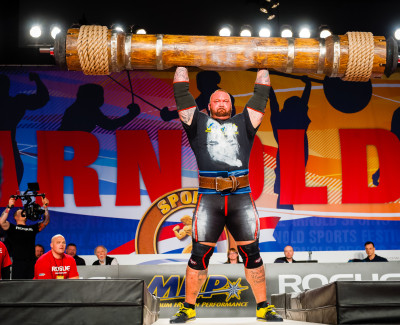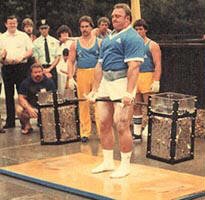I realize
what a zealot I sound like when it comes to Jon Andersen’s Deep Water program,
but I can safely say it’s the most effective training I’ve ever performed, and
my most recent training block has confirmed as such. Before I
discuss it, it’s imperative we understand the dynamics of accumulation and
intensification, because I feel this is where many new trainees (self included)
can get led astray.
It happens more often than you think
Whenever
someone sets a big PR in a lift, people want to know what program that trainee
used to hit that PR, and though that’s an interesting datapoint, its irrelevant
compared to the program used BEFORE the program that set the PR. In
much the same way that the effects of political policy can sometimes only be
felt after the incumbent has vacated the position and a new person takes
charge, PRs tend to be the result of smart off season accumulation blocks
rather than in season intensification phases. The latter is great at
UNLOCKING the potential, but the former is what builds the potential.
And as
such, when looking at my current approach to programming, realize that it’s an
amalgamation of all the things that have worked great for me in setting PRs in
the past. The difference is, BECAUSE of Deep Water, I’m setting much
BIGGER PRs than I have ever done before.
With that
said, here is how I’ve been training to get the most out of my time on that
program.
THE PROGRAM
No
surprise that I stuck with what has always worked for me: a bench day, a squat
day, a press day, and a deadlift day, with a 5th day for
conditioning work. 6 week training cycle.
BENCH DAY
I was
seeing such strong results from the bench day in Deep Water that I kept it
completely as is.
Flat
bench
3x10
3x10
Close
Grip Bench
3x10
3x10
Incline
Bench
3x10
3x10
Dips
3xFailure
3xFailure
I used an
axle for the flat and close grip bench, and a swiss bar for incline, since it
beats up my shoulders less. For progression, I started with 4
minutes rest between sets, and then, each session, took away 30 seconds, before
I finished at 2 minutes per set. I then bumped it back up for 4
minutes rest per set for the final 2 workouts.
In between sets of all my benching, I’d do submax sets of standing ab
wheel. I started with sets of 2, and
then a set of 3 to start the next bench day and sets of 2 for the rest. Then 2 sets of 3 and sets of 2 throughout,
etc. This was done during the rest time.
SQUAT DAY
As usual,
I’m experimenting with the squat training, because I can’t find anything I
like, but experimenting is what got me to Deep Water in the first place, so it
can’t all be bad. I’m pleased with what I’ve structured here.
The main
work is a giant set, consisting of a squat variation, box jumps, and reverse
hypers.
For squat
variation, I rotate each week between buffalo bar squat, SSB squat, and SSB
front squat. The order goes: buffalo bar, SSB, buffalo bar, SSB
front squat, buffalo bar, SSB, repeat. As much as squatting with the
buffalo bar beats up my knee, it makes me strong overall, so I increased the
frequency that I hit it compared to the other 2 bars, but the 1 week on/1 week
off break seems to be helping keep my knee pain free. This was a
lesson that I learned during my time in Deep Water, so I’m making the most use
of it.
In case you have trouble envisioning a SSB front squat
In
addition, the squats is ramping, and trained in waves. By this, I
mean that, I’ll start the training cycle with 10 reps on the first week, 8 in
the second, and 6 in the third, before repeating at 10 again. By
ramping, I mean that I keep those reps the same through all of my warm-up/build
up sets. Typically, I hit my topset by set 5 with this style.
For
example, on my most recent squat workout, it was my third week on the cycle,
and I was using SSB for a ramp-up to 6. Weight and reps looked like
this.
6xBar
6x155lbs
6x245
6x335
6x425
6x335
6xBar
6x155lbs
6x245
6x335
6x425
6x335
I always
ramp up to the topweight I can manage for the day, and follow it with a backoff
set with the weight used for the set previous to that one, just to get in more
weight.
Box jumps
would always be sets of 5. Reverse hyper would start at sets of 8,
then 10 the next week, then 12 the final, before upping the weight. Trying
to balance the work, such that, as squat reps go down, reverse hyper reps go
up.
After the
giant sets are done, I’ll either do some manner of cleans, chins, or walking
lunges. Once again, trying to keep those good things from Deep Water
in my programming. It’s kinda wildcard from there.
I know
people are going to look at this day and talk about how I’m fatiguing myself
before I get to the heavy work, but that’s the point: this allows me to push
the squat hard while keeping the poundages light, which, in turn, keeps my knee
happy. I’ve observed frequently enough that, when I get strong under
fatigue, I’m also strong absent of that fatigue.
PRESS DAY

Went with
a classic staple here of 5/3/1 with a PR set for the topset, then a second set
last PR set after that. In between all sets of that, I did 20 band
pull aparts.
After
that, I’d do a giant set of axle strict press (5x10), dips (5xFailure) and DB
lateral raises (5x10). Percentages were close to BBB, just a little
bit heavier. Once again, all about getting stronger under fatigue. Would
get a gnarly shoulder pump from this.
DEADLIFT DAY


Another
classic staple of ROM progression deads. 6 week cycle, touch and go,
using chains as I’ve written about previously, with 2 rest pause sets at the
end.
After the
mat pull workout, I’d do either a SSB front squat or buffalo bar squat rest
pause/dropset workout. I’d rotate between them each week, and
started with a weight I could get for 10 reps. I’d hit the 10, take
12 deep breaths, go for half as many reps as before (rounding up) and keep that
up until I hit 1. Then I’d strip a plate per side and try to match
10 reps again. The next time I’d use this implement, I’d add 2 reps
to the starting set and repeat. Once I get to 14 reps, I’ll add
25lbs per side and start the whole process over again.
NUTRITION

With this type of training, the volume is low and
the intensity is up, so I ease off the calories. I dropped about 7lbs from where I stopped Deep
Water, and became significantly leaner, most likely as a result of dropping
some bloat along with fat. I still kept
carbs low and protein and fats high, but not to excess.
THE RESULTS
I hit 2
lifetime PRs that I had been chasing for a LONG time. The first was
pressing my bodyweight overhead for 10 reps
and the second was a 15x495lb
deadlift.
Yes, I
know that 15th rep on the deadlift doesn’t really count, but
it’s close enough at this point, and considering the last time I pulled that
weight I had a similar fight on the 14th rep, and this time rep
14 just sailed up, it’s a big victory.
LESSONS LEARNED


- The
benefit of this program I put together is it’s ability to retrain me in
handling heavier loads. While running
Deep Water, once I got to the third phase and went for max weight attempts in
the 5 rep range, I noticed things felt MUCH heavier than they used to. This is to be expected in such a low
weight/high rep training phase. The
point is: don’t freak out when that happens.
In the span of 6 weeks, I got very comfortable with heavy weights, and
set some solid PRs. You just have to
rediscover that strength.
- Deep
Water greatly improved my tolerance for higher rep training. Typically, that squat rest pause workout I’d
do on Saturday would have me limping until about Wednesday, and now I don’t experience
that at all. Seems I’ve unlocked
something special there.
- In a
similar regard, my ability to fight and grind through reps is MUCH better than
it ever was. Witness that 10th
rep on the press and 15th rep on the deadlift. The press especially is something I became
VERY familiar with on the 10x10s with Deep Water, because I’d end a lot of my
later sets with a similar type of press.
- Yet again
I have to express that you SHOULD expect to lift more weight when you lose
weight. It’s not just a thing you do as
a beginner. However, the trick is you
have to intelligently set up your training and nutrition to support that. People time their weight gain and weight loss
to coincide with seasons where they will be with and without shirts, and that’s
their prerogative, but if your goal is to get as big and strong as possible,
eat more food when you can support training with more volume, and when that
volume goes away, drop the volume, up the intensity, and smash some PRs.
"eat more food when you can support training with more volume, and when that volume goes away, drop the volume, up the intensity, and smash some PRs
ReplyDeleteAnd here in, lies the crux of the issue with the endless variations of 5x5 and the advice of "are you stalling? Eat more, while not really upping your volume"
Guilty as heck of that too. I remember when I "went on a bulk" it was 6 hard boiled eggs, 2lbs of chicken, 1 cup of rice, and whatever else was for dinner. Did I get stronger? Maybe. But I also definitely got fatter and I'm sure part of my ability at that time came from having more weight (somehow I bought into the idea if super heavy weights can get a little elasticity on a squat from having a gut that it should be ok) to move around. I don't even know if I knew what a veggie was back then.
Now, I'm just focusing on eating better rather than more and recovery and strength development just seems to be so much better because of it.
I'm sorry I keep beating the dead horse that is 5x5. It's just frustrating how often they get recommended when I saw loads more growth by doing something different.
ReplyDeleteThis program sounds really cool, and I'm happy you set a few awesome PRs from it. Definitely want to run it one day.
I am excited to run it again. I wanna take my ROM progression deads as far as they'll go, but once I'm tapped out, I'll be back.
DeleteYou're gonna run deep water again after the ROM progression stuff?
ReplyDeleteI can't thank you enough for introducing me to Jon Anderson and Deep Water. I love his line of thought on life and the pursuit. Thank you again.
ReplyDeleteReally glad to hear that dude. Glad it's worked well for you.
Delete